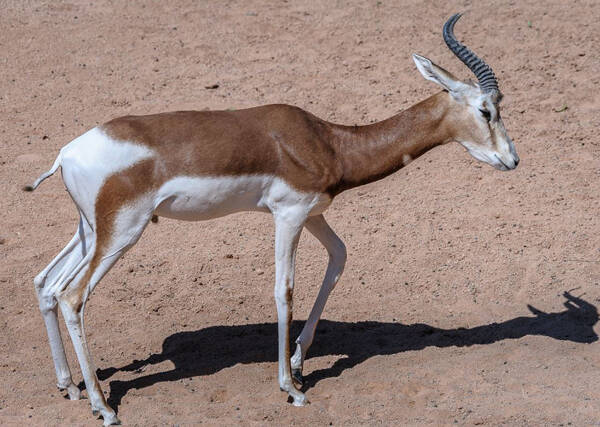Ammodorcas clarkei
IUCN
LCBasic Information
Scientific classification
- name:Ammodorcas clarkei
- Scientific Name:Ammodorcas clarkei,Sand Antelope,Clark's Gazelle
- Outline:Ungulata
- Family:Artiodactyla Bovidae Antelope
Vital signs
- length:152-168cm
- Weight:22-35kg
- lifetime:10-12years
Feature
Small, flat head, large eyes and medium-sized ears, with a thin body, legs and neck
Distribution and Habitat
The sandbuck is found in the Ogaden region of eastern Ethiopia and adjacent areas of northern and central Somalia. The species is found mainly in the arid southeastern lowlands of Ethiopia, with local concentrations in the coastal hinterland of central Somalia.
The sandbuck inhabits semi-arid, dense to scattered scrub, low to medium-high thorn savannah, and plains with a mixture of scrub and grass. The altitude range of its survival is between 200-1,200 meters. The species prefers sandy, rather than moderately gravelly, red soils rich in ferrous oxide, characterized by numerous termite mounds.
Appearance
The sandbuck is a medium-sized antelope. The body length is 152-168 cm, the tail length is 25-35 cm, and the shoulder height is 80-88 cm; the body weight is 22-35 kg. The species has a small, flat head with a wedge shape, large eyes and medium-sized ears. The mouth is small, and the upper lip is slightly elongated. The body is thin, and the legs and neck are long and thin. A prominent feature is the long, curved black tail, which is 25-35 cm long. The species is sexually dimorphic, with males being heavier than females, and only males have curved horns that are 10-25 cm long.
The species has soft and smooth fur, and the fur color blends in with the surrounding environment. The upper body is pale yellow to light gray, and the belly, rump and inner legs are completely white. There are strong facial markings similar to those of a gazelle. Chestnut brown stripes extend from the top of the head to the nostrils of the nose, and there are white parallel stripes on both sides surrounding th
Details
Clark's Gazelle (scientific name: Ammodorcas clarkei), also known as Clark's Gazelle in English, has no subspecies and is a medium-sized antelope.

The sand antelope is a solitary or social diurnal mammal that can move alone or in small family groups of 3-9 individuals. It feeds in the morning and evening and spends the hot days in the shade. Males are usually territorial and mark their territories with urination, defecation, and preorbital gland secretions. These territories are defended by fighting between males. They fight by butting horns and shoving necks, trying to knock their opponents off balance. During preparatory fights, males tuck their noses between their front legs to protect their vulnerable necks and horns. When sandbucks are alerted to danger, they raise their heads and tails and flee.
Sandbucks are herbivorous animals whose diet consists of small buds, leaves, branches and berries from the bush. The long neck of sandbucks enables them to reach high branches and leaves. The animals stand on their hind legs and step on the trees with their front feet to collect. The species is drought-tolerant and can survive in places with little or no open water.
In addition to humans (who are their biggest predators), sandbucks are potential prey for lions, cheetahs, striped hyenas, spotted hyenas and wild dogs. When in danger, the sand antelope hides in the vegetation and, with its long neck, looks into the bushes to assess the danger. The sand antelope remains motionless until the enemy finds it, then bends its back and runs away at full speed.

The breeding season of the sand antelope is mainly from March to May, coinciding with the rainy season. Gestation lasts 6-7 months, and females produce only one calf, born in October or November, with a gestation period of 204 days. The calf matures precociously, standing soon after birth in the bush and strong enough to follow its mother on the first day of life. Sexual maturity is reached between 12-18 months. As with all mammals, females provide nutrition to their young through breastfeeding. Lifespan ranges from 10 to 12 years.
The calf has disappeared from most of its former range (e.g., the northern Ogaden region and part of northern Somalia) and is under great pressure in other parts of its range. In 2013, it was estimated that there were less than 10,000 mature individuals, and the species is estimated to have declined by at least 10% in three generations (14 years) due to poaching, habitat degradation, and drought. Data is very poor, but 2013 estimates suggest there are approximately 4,000 individuals (2,800 mature individuals) in the Central European Gaden region, with an unknown number in Somalia. The species is likely close to the endangered population threshold, but the above figures are likely underestimates, with no evidence of a 20% decline in the last 9 years (two generations).
Drought and habitat degradation caused by overgrazing have affected the survival of the sandbuck throughout its range. Hunting is a threat, exacerbated by political unrest and periodic civil wars and military conflicts over the past 30 years (as of 2013 and still ongoing), leading to the prevalence of weapons and overexploitation of wildlife. However, the sandbuck's agility, the distance it can run, and the difficulty of finding it in dense undergrowth have allowed it to survive locally. Locals consider the species to be more timid and alert than any other antelope, making it almost impossible to kill intentionally, although the meat is preferred for its excellent taste. Uncontrolled development of large quantities of tree and bush charcoal exported to various Mexican states may have adverse effects on habitats.
Listed in the IUCN Red List of Threatened Species in 2016 ver3.1 - Vulnerable (VU).
Protect wildlife and eliminate bushmeat.
Maintaining ecological balance is everyone's responsibility!








